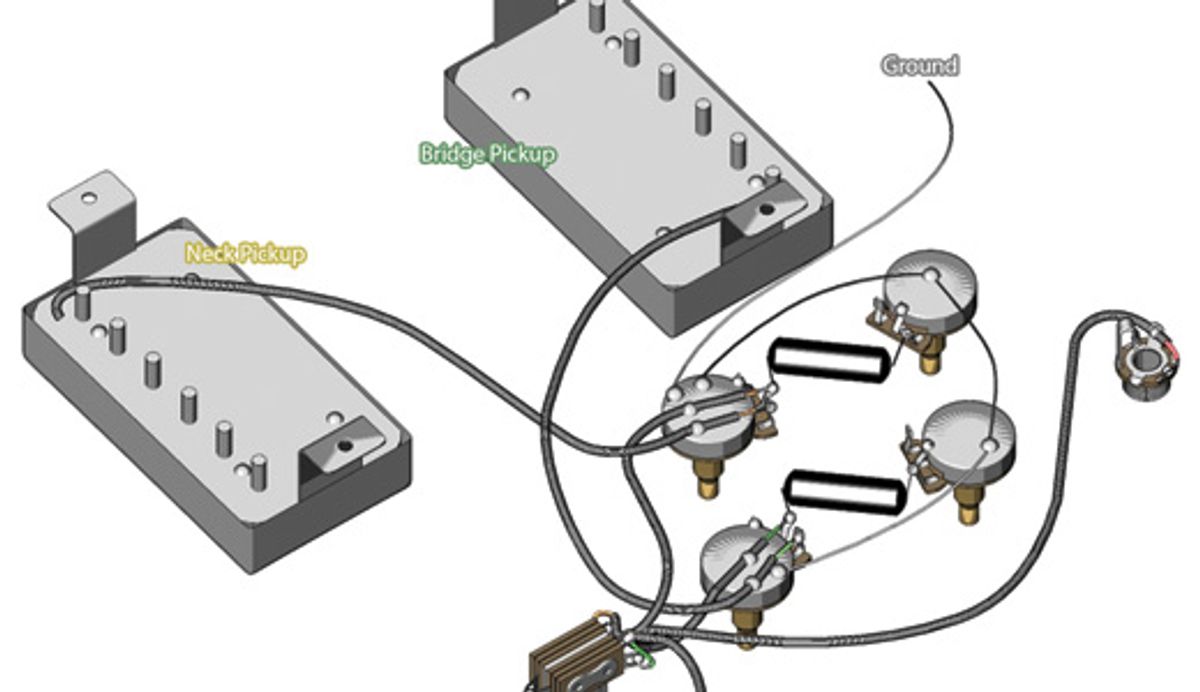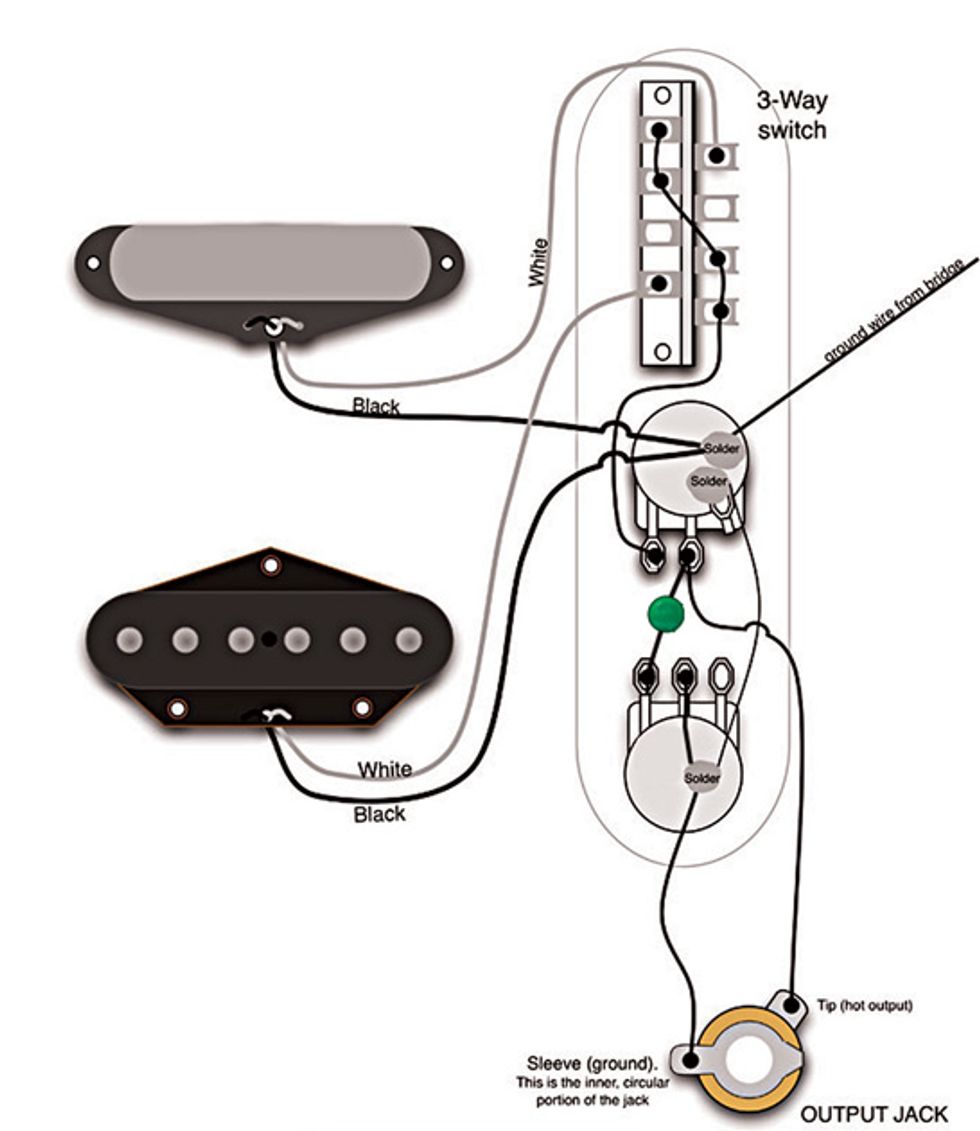
Fig. 1. Gibson's '50s wiring, shown on a Les Paul circuit. Wiring diagram courtesy of Gibson (gibson.com).
It’s easy to wire your Telecaster’s tone and volume controls the way Gibson wired late-’50s Les Pauls.
After pestering you with switching theory for a full three months [“Inside the 3-way Telecaster Pickup Switch," October 2013, “How to Wire a Stock Tele Pickup Switch," November 2013, and “How to Wire Alternative Tele 3-Way Switches," December 2013], it's time to start exploring Telecaster mods.
Let's begin with a simple but great mod that's typically called “the '50s Les Paul wiring." (This wiring is also known as “vintage wiring" or “'50s vintage wiring.") This is the way Gibson wired up their electric guitars in the late 1950s, including the famous “burst" Les Pauls, as well as SGs and ES-335s.
This wiring has been one of the hot topics in guitar forums in recent years, and there are many myths and urban legends about it. After it was forgotten for a very long time, today it seems to be more popular than ever. Electronically, there's nothing too special about this wiring—it simply connects the tone pot to the output of the volume pot (middle lug) instead of the input lug. All late-'50s Gibson guitars were wired this way, but here's the good news: You can do this with any guitar that has at least one volume and one tone pot ... just like our Telecasters!
What's so special about this '50s wiring? It affects your tone in three major ways:
1. The overall tone gets stronger, tighter, and more transparent. It's difficult to describe, but you might say it's more “in your face."
2. The typical treble loss that occurs when rolling back the volume is much less than with standard wiring. Both the volume and tone controls become more responsive, and they react more smoothly without the usual hot spots. Another bonus: By simply rolling back your guitar volume a bit, you can clean up an overdriven amp without getting lost in the mix.
3. The tone and the volume controls interact with each other—something you might be familiar with from certain tweed-era Fender tube amps. When you change the volume, the tone changes a little bit as well, and vice-versa. This may be strange at first, but you only need a few minutes to get used to it.
As always, mods that affect tone are matters of personal taste, but this one is really worth trying. It's simple and invisible, and you can easily revert to standard wiring if you don't like it. Before we heat up the soldering iron, let's take a closer look at what to expect.
I'm sure you've heard about the magical tone of late-'50s sunburst Les Pauls. Perhaps you've been lucky enough to play one—we're all jealous—but we know this tone from our old records. Part of this magic is attributable to the '50s wiring, which makes the tone very transparent and more “direct." The guitar responds much better and without this wiring, it's difficult to get that bloom—the way notes open up after you've played them. It's always difficult to describe sound with words, so your best bet is to give it a try and compare it to standard wiring.
Let's think about the treble-loss issue for a moment. I'm sure you know the inherent idiosyncrasies of passive single-coil pickups and volume controls. On a Telecaster, for example, when you turn down the volume—even just a bit—you lose highs disproportionately to the amount of volume reduction. In other words, a small cut in volume creates a far greater loss in treble response.
You can get rid of this problem by installing a “treble-bleed network"—a combination of a capacitor and resistor wired in parallel or series on your volume pots. But another alternative is the '50s wiring scheme, which may be all you need to deal with this treble-loss issue.
Fig. 2. Gibson's '50s wiring applied to a Telecaster. The tone pot connects to the volume pot's output (middle lug) instead of the input lug. Wiring diagram courtesy of Seymour Duncan (seymourduncan.com).
Here's why: The '50s wiring exhibits much less treble loss that standard wiring because it follows a completely different curve, depending on the ratio of your pot. It works best with audio taper pots, preferably those with a 60:40 or 70:30 ratio. Smaller ratios like 80:20 or 90:10 limit this benefit and result in the typical “on/off" or “bright/dull" problem when using the controls.
Please note: If you currently have a Telecaster with standard wiring and a treble-bleed network, you need to remove the latter when switching to '50s wiring. (Using a treble-bleed network with the '50s wiring negatively impacts the natural evenness of the controls' response.)
Okay, let's begin. First go to seymourduncan.com and download the standard (aka “modern") Telecaster wiring schematic (https://www.seymourduncan.com/support/wiring-diagrams/schematics.php?schematic=standard_tele). Print this out and pin it up at your workbench. This will be our reference for all future mods—and you can bet there will be a lot of them.
Next, check out Fig. 1, which is the Gibson '50s wiring, shown in a Les Paul circuit. Most Les Paul, SG, and ES-335 players with PAF-style humbuckers prefer this wiring because it's one of the key ingredients of old-school Les Paul tone.
When you alter the standard Telecaster wiring to match the '50s Gibson wiring, you get the schematic in Fig. 2. To reiterate: Simply connect the tone pot to the output of the volume pot (middle lug) instead of the input lug used in standard Tele wiring.
See? It's not so hard to apply this to a Telecaster and it's as effective as on a Les Paul. Next month we'll dig even deeper into '50s wiring on a Telecaster, and I'll show you an even simpler way to convert your guitar to these specs. We'll even make it switchable, so you can have both wirings in one guitar. Yeah, life is good!
- Gibson Announces the Grand Opening of the Gibson Garage - Premier Guitar ›
- DIY Relic’ing: Harmony Benton DC-Junior Electronics - Premier Guitar ›
- Mod Garage: Telecaster Series Wiring - Premier Guitar ›
- Mod Garage: Telecaster Series Wiring - Premier Guitar ›
- Mod Garage: Telecaster Series Wiring - Premier Guitar ›
- Fender Esquire Basics - Premier Guitar ›

